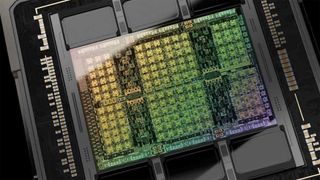Nvidia Allegedly Shifts RTX 4090 Production Over to H100 Hopper GPUs
At least, word has it.

Nvidia has reportedly shifted some orders to Taiwan Semiconductor Manufacturing Co. from GeForce RTX 4090 over to H100 compute processors based on the Hopper architecture. While the information comes from Mydrivers and we could not verify it at press time, there are factors that support the report. It could be a result of the U.S. sanctions of China's supercomputer sector.
Nvidia’s latest gaming and high performance computing (HPC) chips are made using TSMC's customized process technology called 4N, as opposed to generally used N4 (a 4nm-class node that belongs to TSMC's N5 family of fabrication processes). It should be noted that orders to TSMC will not bring an immediate effect on anything given how long it takes to make a modern processor and how ordered are placed. Meanwhile, the information has not been confirmed either directly or indirectly, so take it with a grain of salt.
At the moment Nvidia uses TSMC to produce a host of its GPUs of different complexity, which includes its lates GH100 (80 billion transistors, 814mm^2), AD102 (76.3 billion transistors, 608mm^2), AD103, and AD104 processors. Refocusing allocation at TSMC from one product may not sound too difficult, but there are nuances. Nvidia's AD102 GPU powers the GeForce RTX 4090, which tops our list of the best graphics cards for gaming as of October 2022.
From TSMC's perspective, it does not matter what to produce on its N5-capable production lines. Since both GH (Hopper) and GA (Ada Lovelace) are made on the same fab(s), the foundry has (almost) no problems shifting production within given allocation. Meanwhile, Nvidia also uses TSMC's advanced packaging capacities to make its Hopper GPUs for compute (i.e., it uses one TSMC's 3D Fabric 2.5D technologies to connect HBM3 memory to the chip itself).
From Nvidia's perspective, the situation is quite a bit different. Shifting TSMC's allocation, an uneasy thing to get to on the first place, is one thing. The chipmaker is prioritizing a product that you sell for thousands (Nvidia's H100 products cost $10,000 a piece, whereas consumer-oriented GeForce RTX 4090 carries a recommended price tag of $1,499). While complexity of the AD102 and GH100 is comparable, earnings and margins that Nvidia gets for these products are quite different, which eventually has an effect on the company's research and development buget.
While we all know that demand for graphics cards from gamers is high, the production shift might be a direct result of the U.S. sanctions against China's supercomputer sector, which might have cost Nvidia some $400 million should it not get a waiver to ship compute GPUs to Chinese entities.
Stay On the Cutting Edge: Get the Tom's Hardware Newsletter
Join the experts who read Tom's Hardware for the inside track on enthusiast PC tech news — and have for over 25 years. We'll send breaking news and in-depth reviews of CPUs, GPUs, AI, maker hardware and more straight to your inbox.

Anton Shilov is a Freelance News Writer at Tom’s Hardware US. Over the past couple of decades, he has covered everything from CPUs and GPUs to supercomputers and from modern process technologies and latest fab tools to high-tech industry trends.
-
escksu This is not surprising. Nvidia is trying tp make and sell as many H100/A100 as possible (to China) before the sanctions kick in.Reply
Maybe TSMC is unable to cater for the short term demand from Nvidia or maybe the pricing is too high so Nvidia does this to reduce cost. The margins for H100 is way way higher compared to 4090. -
spongiemaster For the gamers complaining about Nvidia prices and thinking some sort of boycott of their products is going to "teach them a lesson" and get them to lower prices. Here's your answer. As I've said before, Nvidia is more than happy to shift production to enterprise chips where they make significantly more money and don't have to listen to the incessant complaining that gamers love to partake in.Reply -
KTB84 To be fair, this may not be as distressing as it seems to people still looking to purchase a 4090 in the near future. Reports from insiders around the time of the launch were suggesting that there were massive stockpiles of 4090 cards waiting around in warehouses, and that there may have been 3-4x the stock for the 4090 at launch than the 3090. The current supply shortage is likely an artificial one being used strategically by Nvidia to try to move as many 3000 series parts as they can before fully opening up the floodgates of 4000 series parts.Reply -
atomicWAR I can see some political rifts showing up in posts. This is a site for tech news and help. Lets keep the politics out of the conversation please.Reply -
ex_bubblehead As above. Keep the politics to yourself and out of these forums. Any more of it will result in closure of the thread and sanctions being issued to the offending individuals. This is the only warning you will receive and it requires no response.Reply -
Mattzun Not particularly surprising.Reply
The market for people who "need" 4090's and won't settle for a lesser card has to be pretty small and I suspect those people already have 4090s (at least if they had a local Microcenter)
NVidia has already said that they are limiting supplies of other cards and delaying production of 4000 series to keep prices up in the GPU market
If 4090's were readily available at 1600$, who would buy a 4080 for 1200$
Additionally, not meeting the demand for H100's could encourage companies to look at AMD or Intel offerings and NVidia really doesn't want that. -
karlhendrikse This article is unreadable with all its grammatical mistakes and strange wordings. Please learn English.Reply -
USAFRet Reply
Please elucidate specific quotes you have a problem with.karlhendrikse said:This article is unreadable with all its grammatical mistakes and strange wordings. Please learn English.
Thanks.
Most Popular



